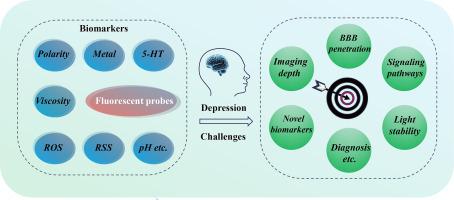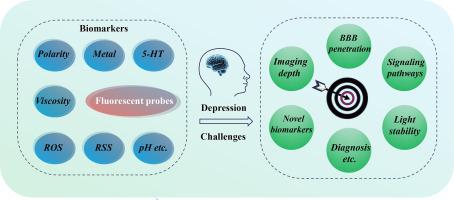小分子荧光探针成像在抑郁症研究中的最新进展与展望
IF 23.5
1区 化学
Q1 CHEMISTRY, INORGANIC & NUCLEAR
引用次数: 0
摘要
抑郁症是世界上最致残的精神疾病之一,它的发病率很高。抑郁症的病因复杂,涉及多种生物活性物质的异常变化,如神经递质、活性氧、生物硫醇、气体信号分子和金属离子。加深对这些物质在抑郁症中的作用的理解对于改善疾病诊断和治疗策略至关重要。近年来,小分子探针成像技术在抑郁症的早期诊断、疾病过程监测、治疗反应评价、新药开发等方面显示出巨大的潜力。本文综述了抑郁症相关生物标志物及其在疾病中的作用,重点介绍了小分子探针在抑郁症模型中的设计原则、识别机制和成像应用。讨论了目前小分子探针成像在抑郁症研究中的挑战,如血脑屏障(BBB)穿透、特异性生物标志物识别、信号通路评估、靶向策略增强、成像深度增强的多模态成像以及多生物标志物探针的开发。最后,展望了小分子成像探针技术在抑郁症研究中的未来发展方向,并提出了提高探针血脑屏障穿透性、降低细胞毒性等建议,以促进该技术在抑郁症诊断和治疗中的广泛应用。本文章由计算机程序翻译,如有差异,请以英文原文为准。


Recent advances and perspectives of small molecule fluorescent probes imaging in depression research
Depression is one of the most disabling mental illnesses in the world, and it has a high incidence of morbidity. The etiology of depression is intricate and involves abnormal changes in a variety of biologically active substances, such as neurotransmitters, reactive oxygen species, biothiols, gas signaling molecules, and metal ions. Deepening the comprehension of these substances' roles in depressive disorders is critically important for improving disease diagnosis and treatment strategies. In recent years, small molecule probe imaging technology has shown great potential in the early diagnosis of depression, monitoring of the disease process, evaluation of treatment response, and development of new drugs. This review details depression-related biomarkers and their roles in the disease, focusing on the design principles, recognition mechanisms, and imaging applications of small molecule probes in depression models. The current challenges of small molecule probes imaging in depression research, such as blood-brain barrier (BBB) penetration, specific biomarker identification, signaling pathway assessment, targeting strategy enhancement, multimodal imaging with imaging depth enhancement, and multi-biomarker probe development, are also discussed. Finally, the future direction of small molecule imaging probe technology in depression research is envisioned, and suggestions such as improving probe BBB penetration and reducing cytotoxicity are proposed to promote the wide application of this technology in the diagnosis and treatment of depression.
求助全文
通过发布文献求助,成功后即可免费获取论文全文。
去求助
来源期刊

Coordination Chemistry Reviews
化学-无机化学与核化学
CiteScore
34.30
自引率
5.30%
发文量
457
审稿时长
54 days
期刊介绍:
Coordination Chemistry Reviews offers rapid publication of review articles on current and significant topics in coordination chemistry, encompassing organometallic, supramolecular, theoretical, and bioinorganic chemistry. It also covers catalysis, materials chemistry, and metal-organic frameworks from a coordination chemistry perspective. Reviews summarize recent developments or discuss specific techniques, welcoming contributions from both established and emerging researchers.
The journal releases special issues on timely subjects, including those featuring contributions from specific regions or conferences. Occasional full-length book articles are also featured. Additionally, special volumes cover annual reviews of main group chemistry, transition metal group chemistry, and organometallic chemistry. These comprehensive reviews are vital resources for those engaged in coordination chemistry, further establishing Coordination Chemistry Reviews as a hub for insightful surveys in inorganic and physical inorganic chemistry.
 求助内容:
求助内容: 应助结果提醒方式:
应助结果提醒方式:


